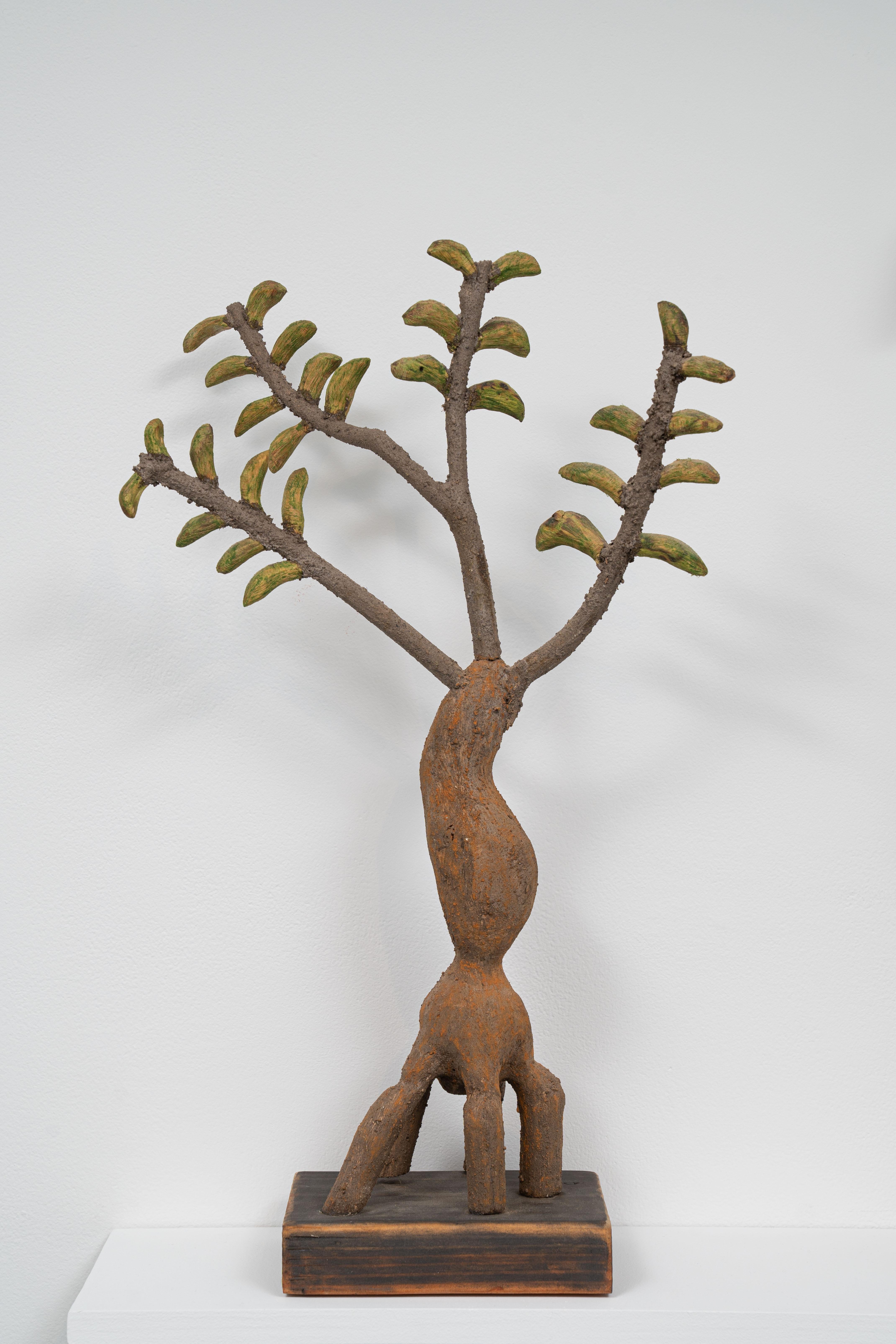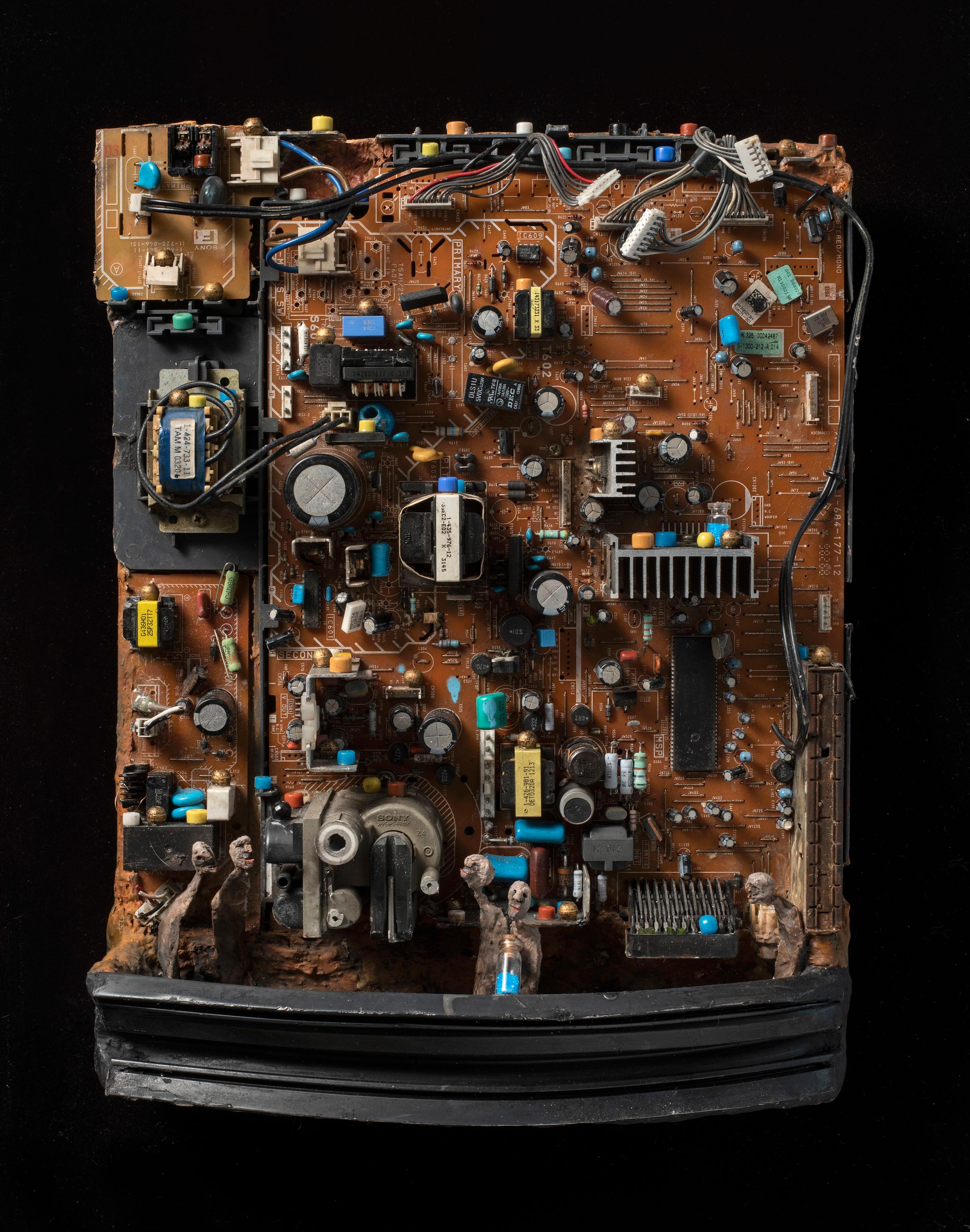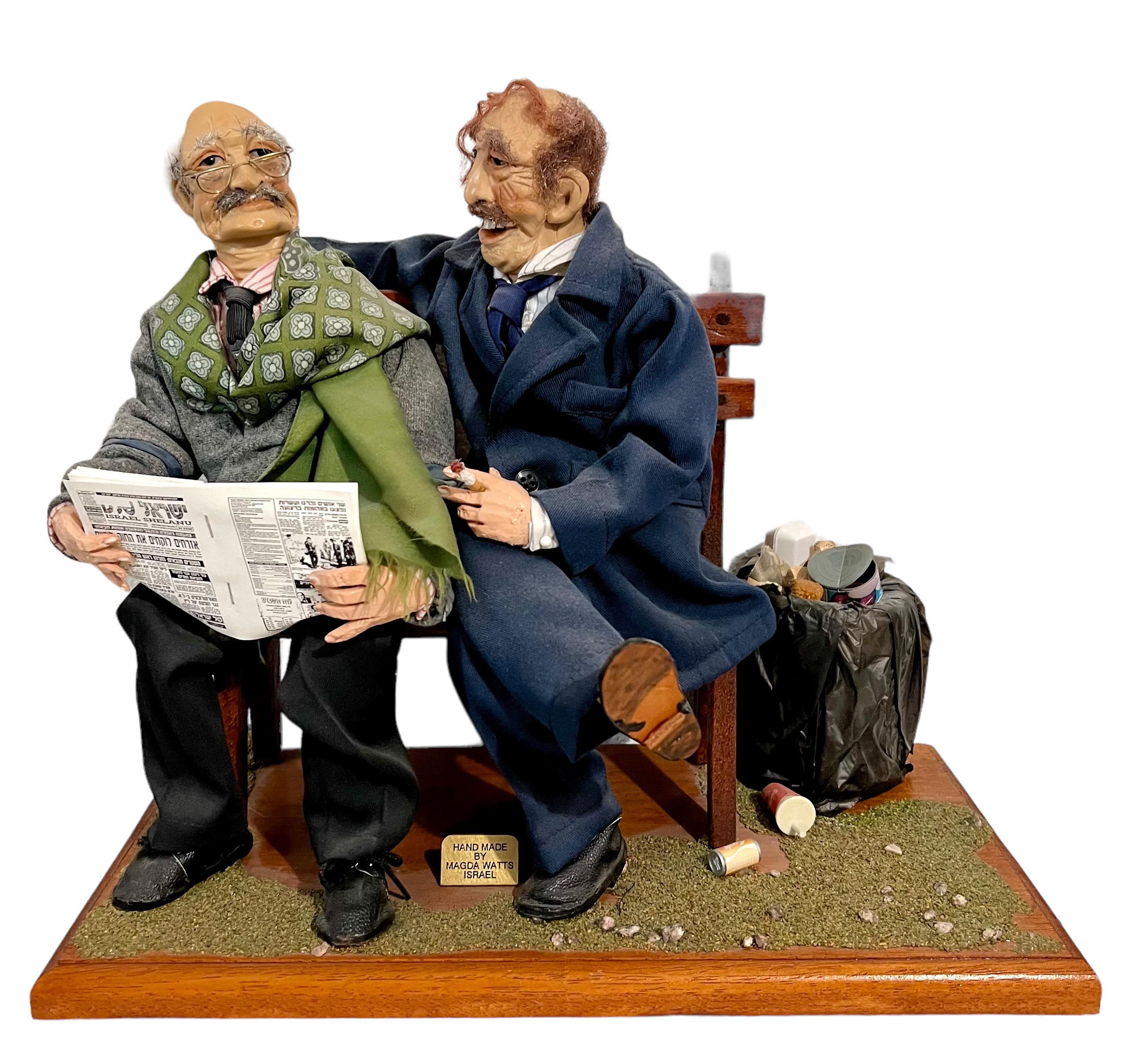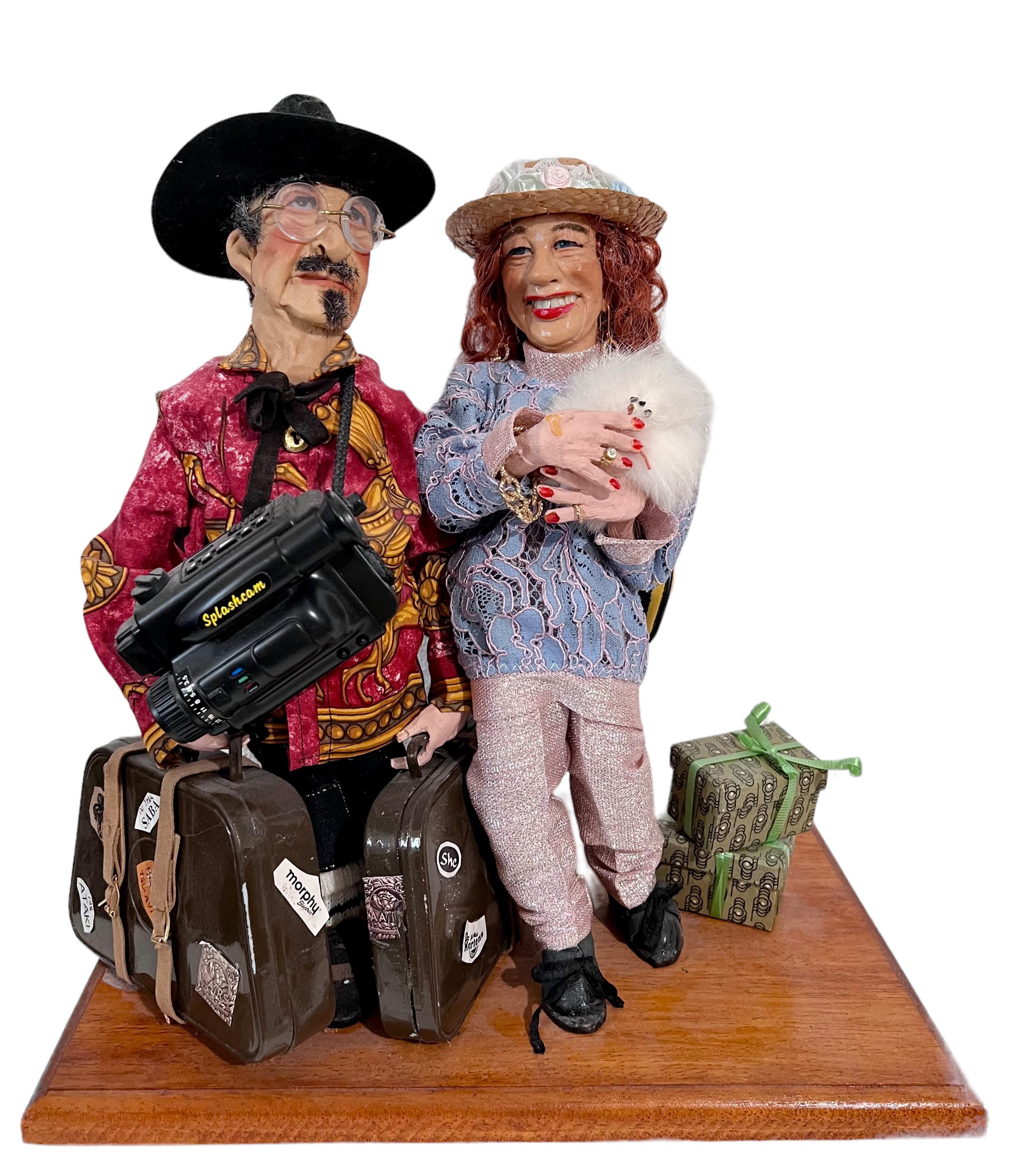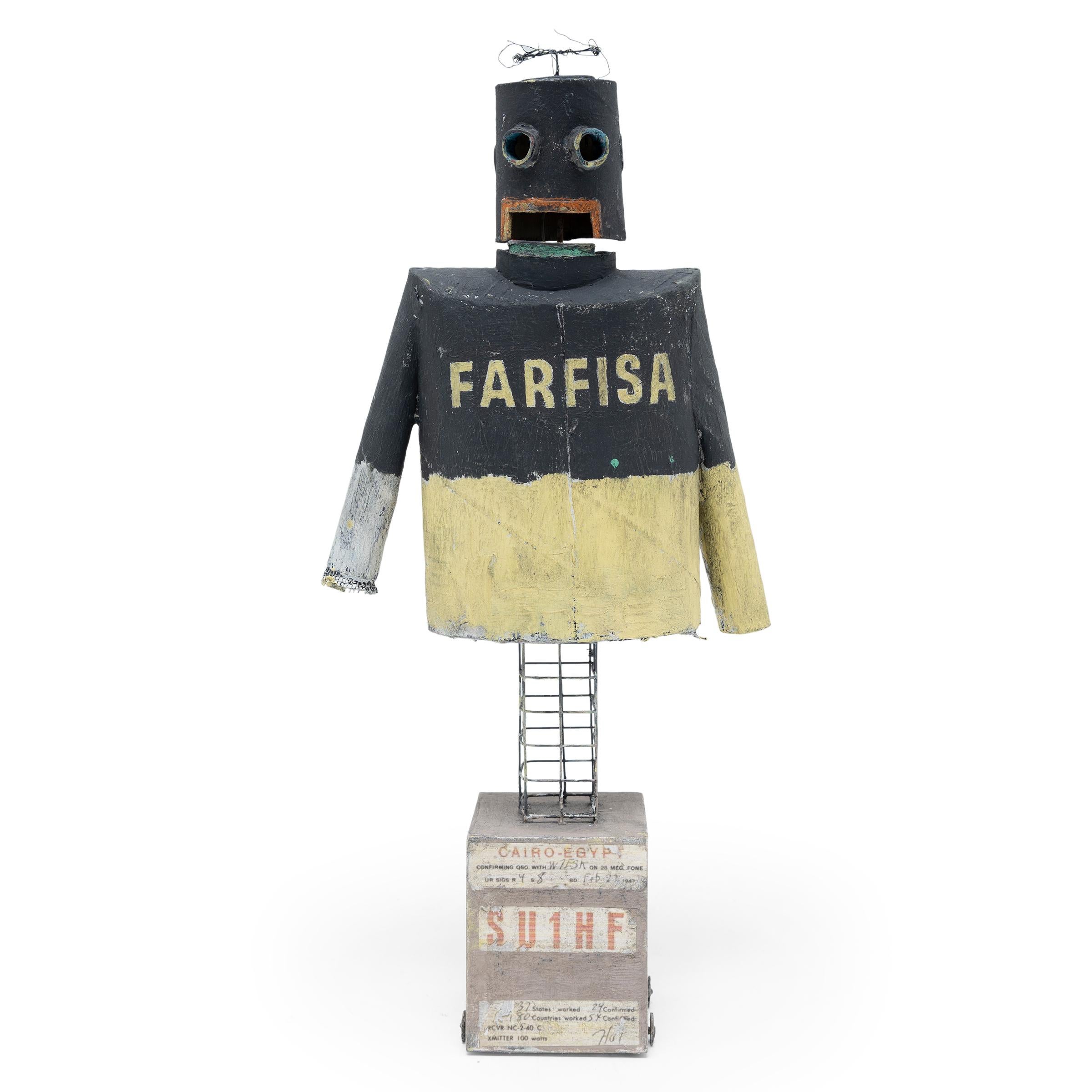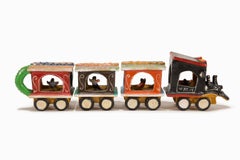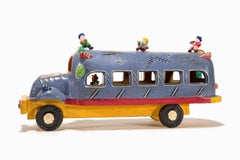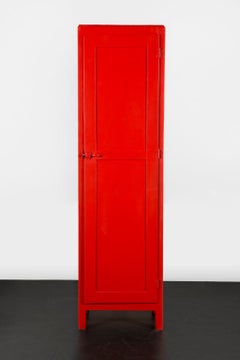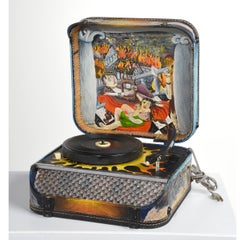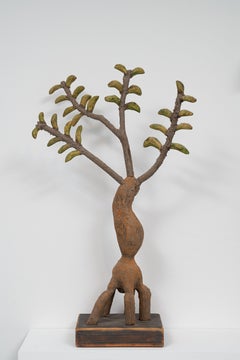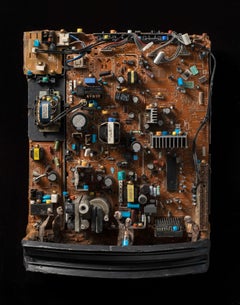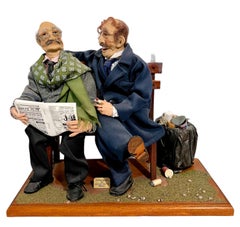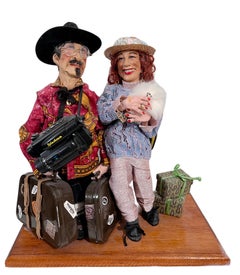Items Similar to Michael German "Leroy & Bertha's Bar and Grill" Mixed Media Sculpture Folk Art
Want more images or videos?
Request additional images or videos from the seller
1 of 12
Michael GarmanMichael German "Leroy & Bertha's Bar and Grill" Mixed Media Sculpture Folk Art
About the Item
During the 1960s America’s storytelling sculptor, Michael Garman, lived a vagabond lifestyle on the cheap and in the run-down neighborhoods of Dallas, San Francisco, Philadelphia and Colorado Springs. Initially, he created one-of-a-kind sculptures. And, as his technique improved, his sculptures became more detailed. Inspired by the people he met on his hitchhiking journey Michael’s early work depicted simple street moments – a tailor mending a garment, a woman on a bench, two ladies gossiping under an umbrella. “Leroy and Bertha’s Bar and Grill” is an example of his enchantment with the underside of life that he had embraced giving him the freedom to move, see and experience whatever he chose.
Born in Fort Worth in 1938 and raised in Arlington, Texas at eight he began creating little pipe-cleaner men. “I would twist pipe cleaners around pipe cleaners to make the muscles, arms and legs, and other features just right,” Michael Garman recalls “I used my mother’s sewing machine to design little cavalry uniforms and cowboy boots. I carved horses out of wood so that some of my guys were mounted. Then I’d gather up all my characters on my bed like a battle scene. I had guns and cannons and horses. Then the great battle began and my hero would get shot. I would arrange him just so, as he was dying. And I would cry and cry for him. I mean, I’d really be sobbing. And then I would scoop them all up and do it over again.”
This story, told by Michael Garman in 1959, was his start becoming America’s Storyteller Sculptor. In ’59 he hitchhiked into Mexico with $35 in his pocket and his Nikon camera for what he thought would be a two-week sojourn. When his money ran out, he would charm his way into a restaurant, offering to sweep the floor or something for a bit to eat or a drink. More often than not, the owner would give him a meal and a place to sleep. “No one I asked hired me, but everyone fed me.”
He hitchhiked his way further south through Central and South America. Two years later, he had traveled all the way to Santiago, Chile where he talked his way for free into the School of Fine Arts. It was here that he discovered his talent for sculpting. “I would sculpt my characters, street people, vendors and such,” Michael Garman relates, “and the school would fire them for free. Then I would go door to door and sell them for five or ten dollars.”
As he had done in South America, as soon as he had a few sculptures finished, he would load them on his motor scooter and sell them door-to-door. Though he eventually made good money, Michael admitted to a growing emptiness. “I began to miss my own work,” he admits. “I discovered that I needed to be surrounded by my little characters, my pals. I still do to this day. I can’t live without my figures around me.”
And so he decided to master the art of reproduction. “Writers do it. Musicians and filmmakers too. Could you imagine if John Steinbeck had only written one copy of The Grapes of Wrath?” Michael asks. “And only one person, one rich muckity-muck was able to read those words?! What a crime that would be. What a loss! As a sculptor, I can do the same thing that a writer or a musician does. I can publish my art. The trick is to make sure that every reproduced copy is just as detailed, just as rich and just as authentic as the original. Sure, it’s hard to master. But it’s supposed to be hard. That’s what makes it fun.”
In the late 1960s, Michael Garman moved into the SoMa (South of Market St. – cheaper area) region of San Francisco where he found a studio above an old print shop. “Man, I landed in the center of wino town,” Garman recalled. “I loved it.” Inspired by the neighborhood, Michael’s sculptures began to become more realistic, gritty, and honest. Soon he began working at a local theatre company. It was here that he learned stage craft, illusion, as well as good business. “It was an important time in my life; that was my Harvard Business School,” Garman relates.
After years spent as a real-life vagabond throughout North and South America, Michael Garman eventually settled in Colorado Springs in 1971. It was here that he perfected his gritty, Americana style. He also began a 40-year project to bring to life his vagabond experiences with a new art form – sculptural theater.
He began work on Magic Town in 1975, and opened it 10 years and 1 million dollars later. “It’s a work-in-progress,” he admitted. And over the following three decades, Michael has added magical illusions, holographic effects, detailed alleyways and more. “Think of a 3,000 square-foot dollhouse,” Michael describes. “A gritty blend of Walt Disney and Norman Rockwell.”
Peek into a window and you might see a woman teaching piano lessons. Then the Magic-Town fade. A few seconds later, the lights come up and all the figures in the scene have changed. Now, as you peer into the window, you discover Michael Garman himself, back in his San Francisco studio sculpting a favorite piece – Flying Leather.
Each scene captures a moment in time – a pool player leans into his shot, hoboes warm themselves by a garbage-can fire, a baseball team celebrates their victory at the local pub, three men sneak into the alley to play craps, and a weary short-order cook steps outside for a smoke break as a pretty girl plays the Wurlitzer.
In addition to building Magic Town, Michael Garman has dedicated the past fifty years to creating hundreds of sculptures that honor American heroes from all walks of life. Among his many sculpture series – Early American, Military, Firefighters, Linemen, Law Enforcement, Western, and many more – a theme emerges. Michael Garman’s art pays tribute to the extraordinary everyday heroes all around us: the firefighters, soldiers and police who run into danger, the doctors who treat our wounds, the lonely cowboy facing the long trail ahead, and the down-but-never-out street character with a twinkle in his eye.
All of his nearly 500 sculptures are reproduced by hand in Colorado Springs. Michael Garman’s inspiration has always been to tell an honest story, and recreate it in an honest way. This is Michael Garman’s “Art for the People.”
- Creator:Michael Garman
- Dimensions:Height: 27.25 in (69.22 cm)Width: 18.75 in (47.63 cm)Depth: 10 in (25.4 cm)
- Medium:
- Movement & Style:
- Period:
- Condition:
- Gallery Location:Detroit, MI
- Reference Number:1stDibs: LU128618595532
About the Seller
5.0
Vetted Professional Seller
Every seller passes strict standards for authenticity and reliability
Established in 2014
1stDibs seller since 2019
107 sales on 1stDibs
Typical response time: 1 to 2 days
- ShippingRetrieving quote...Shipping from: Detroit, MI
- Return Policy
Authenticity Guarantee
In the unlikely event there’s an issue with an item’s authenticity, contact us within 1 year for a full refund. DetailsMoney-Back Guarantee
If your item is not as described, is damaged in transit, or does not arrive, contact us within 7 days for a full refund. Details24-Hour Cancellation
You have a 24-hour grace period in which to reconsider your purchase, with no questions asked.Vetted Professional Sellers
Our world-class sellers must adhere to strict standards for service and quality, maintaining the integrity of our listings.Price-Match Guarantee
If you find that a seller listed the same item for a lower price elsewhere, we’ll match it.Trusted Global Delivery
Our best-in-class carrier network provides specialized shipping options worldwide, including custom delivery.More From This Seller
View All"El Tren" Ceramic, Glaze, Colors, Mexican Folk Art, Four Sections
Located in Detroit, MI
SALE ONE WEEK ONLY
"El Tren" is a whimsical and playful rendition of a train. It is beautifully glazed in various colors.
This particular ceramic was from the collection of Jane and Richard Knight’s Estate. Jane Knight was a famous fiber and textile artist. Richard was a photographer who worked for Eliel Saarinen and Alexander Girard. The Knights and Girard became close friends and it was Girard who gifted “Santa Cruz De Las Huertas Jalisco” to the Knights. Alexander Girard left his personal collection to the Museum of International Folk Art, Santa Fe, NM. The Girards eventually amassed a collection of more than 106,000 objects from across the globe. Their 1978 gift of this collection to the Museum of International Folk art quintupled the size of their collection and prompted the construction of a new wing, which opened in 1982 and houses a mere 10% of the Girard Collection in the permanent exhibition Multiple Visions: A Common Bond, which was designed by Alexander Girard himself. This collection includes numerous multiples and is notable for its great breadth, including traditional arts, popular arts, and paper ephemera. “I believe we should preserve this evidence of the past, not as a pattern for sentimental imitation,” Girard once said, “but as nourishment for the creative spirit of the present.” Indeed, folk art was an important inspiration for Girard’s design work.
The renowned Candelario Medrano...
Category
1950s Folk Art Still-life Sculptures
Materials
Ceramic, Glaze
“Santa Cruz de las Huertas Jalisco”, Ceramic, Glaze, Colors, Mexican Folkart
Located in Detroit, MI
SALE ONE WEEK ONLY
“Santa Cruz de las Huertas Jalisco” is a whimsical, charming and colorfully ceramic rendition painted blue and red of a local bus that traversed the town where the artist Candelario Medrano...
Category
Mid-20th Century Folk Art Figurative Sculptures
Materials
Ceramic, Glaze
"Kryptonite Wares", Found Objects 2015/2019, Chartreuse & Red, House Paint
Located in Detroit, MI
"Kryptonite Wares" is a clever and humorous collection of both superfluous and everyday objects purchased from the Dollar Store. It is a wry comment by the artist on the overabundanc...
Category
2010s Assemblage Still-life Sculptures
Materials
Plastic, Wood, Found Objects, Lights, Mixed Media, House Paint
Jerome Ferretti "Record Player" Symphonic Record Player Speakers
Located in Detroit, MI
"Record Player" by Jerome Ferretti, Detroit muralist, painter and sculptor, is a genuine Symphonic Record Player with built-in speakers that Je...
Category
1990s American Modern Still-life Sculptures
Materials
Acrylic, Wood
Palissy Majolica Bowl Snake Spider Frog Caterpillar Butterfly Lizard
Located in Detroit, MI
This Jose A Cunha Portuguese Palissy Majolica plate features a snake, spider, frog, caterpillar, and butterfly on green shredded clay ground. The piece bears the maker's marks for Jose A Cunha pottery. Palissy ware is a style of ceramics that is also known as rusticware due to their earth-toned palettes and naturalistic plant and animal scenes that are cast to it. The style was coined in reference to the 16th century French potter Bernard Palissy and experienced a significant revival in the 19th century thanks to Charles-Jean Avisseau. It's strongest revival however was in Portugal where it was produced by the potteries of Mafra, Jose A. Cunha, Alves, José Francisco de Sousa...
Category
19th Century Still-life Sculptures
Materials
Earthenware, Majolica, Glaze
"Pod", Decorative Tatooed Sculptural Ceramic with Transparent Glaze
By Michele Oka Doner
Located in Detroit, MI
"Pod" is a precious sculpture with a decorated tactile surface and a warm glaze giving the piece a soft glow. The transparent glaze enhances the creamy tones of the clay. Ms. Oka Doner created unique hand-size sculptures during the 1960s of which the "Pod" is an exquisite example. Her clay technical skills cover a wide range from enormous wall pieces to small decorative pieces that demand to be touched and held. This piece, despite being a fruit, is the perfect example of her famous "Tatooed" figurative sculptures.
Michele Oka Doner (born in Miami Beach, Florida, United States) is an American artist and author who works in a variety of media including sculpture, prints, drawings, functional objects and video. She has also worked in costume and set design and has created over 40 public and private permanent art installations. She is best known for her “A Walk On The Beach,” a one and a quarter mile long bronze and terrazzo concourse at Miami International Airport. It is composed of over 9000 bronzes embedded in terrazzo with mother-of-pearl. At one and quarter linear miles, it is one of the largest artworks in the world.
She is granddaughter of painter, Samuel Heller. She attended the University of Michigan, Ann Arbor. Her art instructor Milton Cohen was experimenting with The Space Theater and George Manupelli began the Ann Arbor Film Festival. Their students were engaged in poetry, dance, light, music, all combined into a unitary vision, a motif that shaped Oka Doner's student years and is characteristic of her work today. She participated in a Manupelli experimental film, a "Map Read" performance with art drawing instructor Al Loving and Judsonite dancer Steve Paxton as well as several "Happenings." Another influence was art historian and Islamic scholar, Oleg Grabar, who illustrated how patterns in architecture are able to dissolve space.
She received her BS and MFA from the University of Michigan in Ann Arbor. In 2008 she was a U of M Penny Stamps Distinguished Speaker. Solo exhibitions of her work have been held at the Detroit Institute of Arts, Michigan; Germans Van Eck Gallery, New York; Diane Brown Gallery, New York; Art & Industrie Gallery, New York; Willoughby, Marlborough Gallery, New York; Studio Stefania Miscetti in Rome; and Gloria Luria Gallery in Miami, Florida.
During the 1960s Michelle Oka Doner was living and working in Detroit, Michigan, where she became acquainted with Charles McGee and his gallery located in the Fisher Building...
Category
1960s Still-life Sculptures
Materials
Ceramic, Glaze
You May Also Like
Sculpture of a tree: '5r'
By Loren Eiferman
Located in New York, NY
Eiferman invite’s you to immerse yourself in a world where transformed shapes, lines, and colors are all crafted out of nature's detritus. The inspiration for her drawings come from ...
Category
2010s Folk Art Still-life Sculptures
Materials
Wood, Mixed Media
Outsider Art Wall Sculpture: 'Electric Factory'
By Gerard Cambon
Located in New York, NY
Gérard Cambon was born in 1960 in Toulouse (Fr).
He has a degree in political science and is a self-taught artist.
In the earlier years of his life practiced and experimented with c...
Category
2010s Outsider Art Figurative Sculptures
Materials
Metal
Hungarian Israeli Tourists Diorama Folk Art Doll Judaica Sculpture Magda Watts
Located in Surfside, FL
Magda Watts (Israeli, b. 1928)
Handmade Folk Art Sculpture
Old Folks with a newspaper
Hand signed to underside,
Dimensions: 12"h x 14.5" l x 7.5"d.
Mag...
Category
20th Century Folk Art Figurative Sculptures
Materials
Fabric, Wood, Mixed Media
Hungarian Israeli Tourists Diorama Folk Art Doll Judaica Sculpture Magda Watts
Located in Surfside, FL
Magda Watts (Israeli, b.1928)
Handmade Folk Art Sculpture
Tourists.
Hand signed to underside,
Dimensions: 12"h x 14.5" l x 7.5"d.
Magda Watts, Holocau...
Category
20th Century Folk Art Figurative Sculptures
Materials
Fabric, Wood, Mixed Media
"XMITTER" Helmet & Jacket Sculpture
Located in Chicago, IL
To Chicago-based artist Patrick Fitzgerald, his sculptures are a means of traveling through time. Working from found materials, Fitzgerald constructs miniature soap box cars...
Category
21st Century and Contemporary Outsider Art Figurative Sculptures
Materials
Wire
"Grocery Getter, " Mixed-Media Sculpture
Located in Chicago, IL
To Chicago-based artist Patrick Fitzgerald, his sculptures are a means of traveling through time. Working from found materials, Fitzgerald constructs miniature soap box cars...
Category
21st Century and Contemporary Outsider Art Still-life Sculptures
Materials
Wire
Recently Viewed
View AllMore Ways To Browse
German Wood Sculpture
Michael Good
Money Sculpture
Used Grills
Sculptured Bed
Grape Sculpture
German Uniform
Sleeping Sculpture
Still No Lights
Mexican Folk Art Sculptures
Girl Folk Art
10 Foot Bars
Horse Sculpture Folk Art
Vintage Bed Springs
Folk Art Carved Horse
Bench Folk Art
Folk Art Soldier
Used Theater Lights
